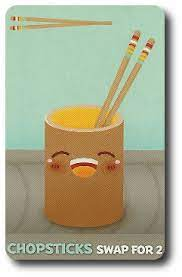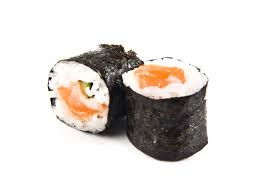In this series, "Eric's House Rules" I write about rules that I add to games that I play. I am not a professional game designer, but I have some ideas that some people have some fun with.
My understanding of good game design might be different from yours. In general, my house rules are crafted to increase player agency while maintaining simplicity and elegance. They also seek to create memorable moments and minimize player frustration, both of which are pretty subjective, of course. I've convinced some of my friends and family to try some of my house rules, and I encourage you to do the same. But you don't have to.
"Sushi Go“ is a drafting game, similar to 7 Wonders. The illustrations are cute. It is about as simple as a drafting game can be. It seems to be pretty popular because I've seen it in lots of bookstores in New England. It's from Gamewright, a company that has made a name for itself producing simple games for children, a category where Sushi Go fits right in.
Link to online PDF of Sushi Go! Rules
House Rule #1: "Reverse Wasabi"
Original Game:
If you play Wasabi, then play a Nigiri, the Wasabi triples the value of the next nigiri you play.
House Rule:
If you play Wasabi, then play a Nigiri, the Wasabi modifies the value of the next Nigiri you play according to the following:
Egg => 8
Salmon => 6
Squid => 4
Why try it?:
Squid is already the strongest card in the game; it doesn't need the added bonus of growing even stronger in combination with Wasabi. Squid is the strongest card because its Points-Per-Card (PPC) is always at least 3, which is a very good rate. Compare it to Tempura, whose PPC is a mere 2.5 and only if you assemble two of them. Because Squid is the best card, it's nearly always correct to pick a Squid when you see one, whether you already have a Wasabi in front of you or not.
See a Squid, take a Squid. I think this is boring. I think drafting games are more fun when the value of the cards is more dynamic and context-dependent. For example, a Sashimi is worth more to a player with 2 Sashimi in play than to a player with none. When cards have different values to different players, it creates scenarios where the best pick is not as obvious as "See a Squid, take a Squid." Ya gotta think 'n' stuff.
Consider the following scenarios that can only occur when you try the "Reverse Wasabi" House Rule.
Scenario A: The neighbor you're passing to has a Wasabi in play. You have a Salmon in play. Your current hand contains an Egg and a Squid (and several other unimportant cards). Which do you take? If you take Squid, you'll have 5 points total, but your opponent be able to make 8 points next turn. If you take Egg, you'll only have 3 points total, but your opponent will only be able to make 4 points next turn.
The correct answer requires you to consider each player's current standing. If the neighbor you're passing to is very far behind, it might be correct to let them have the 8 point Wasabi-Egg combo because they're not a threat to you; thus, maximizing your own points is more important. With the original rule, the correct answer is always Squid.
Scenario B: Everyone but you is ready to reveal their 3rd pick of the round. You remember that the hand you just passed to your neighbor contained a Wasabi, but will they pick it? Your current hand contains an Egg and a Squid. Which do you take? If you take the Squid, you'll maximize your own points, but you run the risk of setting your neighbor up for a Wasabi-Egg combo.
Here you have to consider everything you did in Scenario A, but there's also an element of risk. Does that neighbor tend to take Wasabi? Are there more Eggs coming in the next hands anyway? (which would mean it's harder to try and "cut off" your neighbor from them).
Scenario C: You have a Wasabi and two Dumplings in play. Your current hand contains a Salmon and a Dumpling. Which do you take? If you take the Salmon, you'll get 6 points, but you'll use up your Wasabi and won't have it if you get passed an Egg in a later turn.
With the original rule, you shouldn't turn down a Wasabi-Salmon combo just for the chance at a Wasabi-Squid combo because the chance of getting passed a Squid is so low (because Squids are good cards that get taken immediately!). When the big Wasabi-combo is Wasabi-Egg, however, there's a higher chance you'll get both pieces because to people without a Wasabi, Egg is worth just 1 point.
Finally, I chose the numbers 4, 6, and 8 because the sequence 4-6-8 is pretty easy to remember, but I'm not married to these numbers. 5-6-7 might be better. Or something totally different - try it out. I concede that the original rule of "triple the Nigiri's points" is simpler and easier to remember, but if you've played a lot of Sushi Go and want more dynamic games, try reversing your Wasabi. If you find that too many people are getting 8 Point combos and it's warping the game, you can try removing an Egg Nigiri or two from the deck (there are only 5).
House Rule #2: Chopsticks as Last Card
Original Game:
If you have Chopsticks in play at the end of the round, it's worth nothing.
House Rule:
If you have Chopsticks in play at the end of the round, discard it and replace it with the top card of the deck (the remaining cards that were not dealt to players).
Why try it?
I think it's pretty lame that you can get passed Chopsticks in the last turn of a round and there's nothing you can do about it. It's a feel-bad moment. Why not give that poor player a sliver of hope? The opportunity cost -- measured in game balance and complexity -- is low. A random card from the top of the deck usually won't be worth much (if anything), so this house rule -- while it adds an element of luck -- probably won't actually change the outcome of too many games.
But when it does, boy oh boy, will it be memorable. And for me, memorable moments are what games are all about.
I'm not sure if this house rule should be more restrictive, ie. if it should only apply if you're passed Chopsticks as the last card in a round. There are good arguments for both, but I think the less restrictive version is easier to remember and maybe more fun.
House Rule #3: Maki Points
Original Game:
The player with the most Maki Rolls receives 6 points. The player with the second most receives 3 points.
House Rule:
The player with the most Maki Rolls receives 7 points. The player with the second most receives 4 points. (or 8 Points, 4 Points, I dunno)
Why try it:
I'm pretty sure Maki are bad. To have the most Maki rolls, you need to dedicate at least two, usually three picks to Maki. That means that even if you achieve first place, the PPC (Points-Per-Card) is still only 2, maybe 3 Points. That's not much better than Salmon or Dumpling, which are much safer investments. The problem is that collecting Maki is inherently riskier. I believe this risk should be better rewarded.
The first reason Maki is riskier is that the Maki cards themselves are more variable. Sure, all cards in Sushi Go are subject to the variability of the cardpool (the sum of all cards among all starting hands in a given round). Until you've seen every hand, you don't know how many copies of a given card are in the cardpool (worst case scenario: you pick a Sashimi first turn, not knowing that there's only one other Sashimi this round). The additional variability of Maki is that there are three versions of them, distributed as follows.
1-Roll-Maki: x6
2-Roll-Maki: x12
3-Roll-Maki: x8
That means that on your first turn, not only do you not know how many total Maki cards there are, you don't know how many total Rolls there are. This makes it harder to estimate how many picks you need to dedicate to Maki to win first place. Maybe this round is full of lots of 2-Rolls and 3-Rolls and you need 12+ Rolls to win. Maybe there's just a bunch of 1-Rolls. You just don't know!
The second -- and more important -- reason Maki is riskier is that their point value is dependent on the actions of other players. Best case scenario if you're pursuing a Maki strategy: you pick one or two Maki cards and gain an early lead that no one else challenges. The Maki cards you don't pick are distributed among the other players more or less at random. But the worst case scenario: you find yourself in an arms race with another player, where you need to spend lots of picks on Maki to defend your lead (opportunity cost). But it's really a race to the bottom because no matter how many Maki Rolls you have, the most you can ever get is 6 Points. But if you lose the race, it's a piddly 3 (the same as a single Squid).
I'm unsure if 7 Points for first and 4 Points for second are the right numbers, but I'm very sure that, in the original game, Maki cards are very weak. Boosting them makes them a viable strategy compared to other cards.
House Rule #4: Maki Ties
Original Game:
If multiple players tie for the most [Rolls], they split the 6 points evenly (ignoring any remainder) and no second place points are awarded.
House Rule:
If multiple players tie for the most Rolls, the player with the most Maki Cards wins. If multiple players have the same number of Maki Cards, they all receive the full points and no second place points are awarded.
In the section about House Rule #3, I made my case as to why Maki is weak (low PPC, despite high risk). It turns out there's another reason why Maki is weak in the original game: if you get into an arms race with another player (already the worst case scenario), you'll end up with a piddly 3 points not only if you lose, but also if you tie (which is not uncommon!). This is stupid. Pardon my bluntness, but I cannot fathom why the game designers chose this scoring method, especially when there's already an established procedure for this exact situation in other games.
That procedure is: when two players tie for first, take the points awarded for first, add it to the points for second, divide the total by two (round up or round down if necessary) and give that many points to each player (adjust as necessary if more than two players tie).
You can play Sushi Go with that established procedure if you like, but I'd like to go a step further. First, let's introduce a tiebreaker: if multiple players have the same number of Rolls, then look at the total number of Maki Cards. It's only fair to reward the player that invested more picks in Maki. And ties are lame, right?
But even with this tiebreaker, there will still be ties. Second step: let's remove some of the "race-to-the-bottom"-aspect of Maki Rolls and introduce a non-zero-sum alternative. Let's award the full points to all players with the most Rolls and an equal number of Cards. Why? Because it gives players a chance to cooperate (or backstab!). Normally two players collecting Maki Rolls are rivals, but if they cooperate, they can both win (and gain an advantage over the other players). Achieving this cooperation is not guaranteed, though; at any point, a non-Maki player can swipe a critical card. Or going into the final round, when two Maki-players have the same number of Rolls and have agreed to not take any more, one of them can backstab the other by taking a final Roll.
Change #5: Maki Mirror
Original Game:
n/a
House Rule:
At the end of the round, if the number of Maki Rolls you have is equal to the number of points you have from non-Maki, non-Pudding cards, double your score.
This rule is weird. Here goes.
Sometimes things go wrong. Sometimes all you get is a Nigiri, a Sashimi, a Dumpling, a Tempura, an unused Wasabi, some Maki, and Chopsticks. That's too bad. The Maki Mirror House Rule gives you an "emergency button" that lets you salvage an otherwise horrible round. What would have been a horrible 3 Point Round can become... with a little luck and work... a less-painful 6 Point Round.
It's also an interesting alternate strategy. Normally Maki Rolls are only useful if you're trying to get the most, but now there's the alternative of angling for 2nd place on total Maki Rolls while also receiving a juicy Maki Mirror bonus.
I also don't like games where cards are strictly better than other cards (ie. better in all situations). In the original game, 1-Roll Maki is always worse than 2-Roll and 3-Roll Maki. With the Maki Mirror rule, there's at least a few niche cases where a 1-Roll Maki is preferable to the others.
I admit that this rule is a little weird, and I've never actually gotten anyone to try it with me, but it might be fun enough to justify the added complexity.
House Rule #6
Just add another Sashimi to the deck.
Make the total number of Sashimi divisible by 3! Please. Mostly an aesthetic argument, but c'mon, I just want to live the dream of a 9 Sashimi, 30 point round (in a 3-Player game). Also, Sashimi are kind of weak and could use a little help.
















